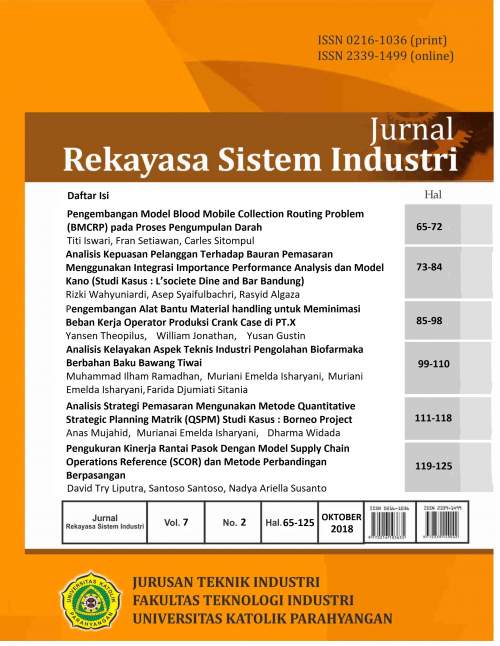Pengembangan Model Blood Mobile Collection Routing Problem (BMCRP) pada Proses Pengumpulan Darah
DOI:
https://doi.org/10.26593/jrsi.v7i2.2769.65-72Abstract
This research develop a model of blood mobile collection using blood donor vehicle efficiently by determining the optimal route of blood collection to the points of blood collection. The model developed in the form of mixed integer nonlinear programming (MINLP) and this model is called Blood Mobile Collection Routing Problem (BMCRP). The purpose of this model is to minimize the total distance of the blood collection routing process in which each place of blood collection has the opening hours and the closing time (time windows) and the service time in each place. This study considers the blood age (spoilage time) for 6 hours to ensure blood quality. The mathematical model is then verified to determine whether the solution is in accordance with the characteristics of BMCRP. Verification is done by solving Blood Mobile Collection Routing small cases. The simulation of solving BMCRP is done by generating eight hypothetical data sets of small cases based on vehicle routing data problems with different characteristics. Verification of BMCRP uses LINGO software. From the simulation results, the BMCRP model can obtain optimal solutions with minimum total distance travelled and does not violate any constraints on BMCRP.
References
American-Association-of-Blood-Banks. (2007). The 2007 National Blood Collection And Utilization Survey.
Dantzig, G. B. and J. H. Ramser. (1959). The Truck Dispatching Problem. Management Science 6(1): 80-91.
Doerner, K. F., M. Gronalt, R. F. Hartl, G. Kiechle and M. Reimann. (2008). Exact and heuristic algorithms for the vehicle routing problem with multiple interdependent time windows. Computers & Operations Research 35(9): 3034-3048.
Dumas, M. B. and M. Rabinowitz. (1977). Policies for Reducing Blood Wastage in Hospital Blood Banks. Management Science 23(10): 1124-1132.
Gunpinar, S. and G. Centeno (2015). "Stochastic integer programming models for reducing wastages and shortages of blood products at hospitals." Computers & Operations Research 54: 129-141.
Gunpinar, S. and G. Centeno. (2016). An integer programming approach to the bloodmobile routing problem. Transportation Research Part E: Logistics and Transportation Review 86: 94-115.
Iswari, T., Yu, V.F., dan Asih, A.M.S. (2016). A Simulated Anealing Heuristic for Blood Pick-Up Routing Problem. Electronic Thesis and Dissertation (ETD) National Taiwan University of Science and Technology. Diakses dari: https://pc01.lib.ntust.edu.tw/ETD-db/ETD-search/view_etd?URN=etd-0620116-133237 [2017, 1 Maret].
Kementerian Kesehatan Republik Indonesia. (2016). Ketersediaan Darah ditentukan partisipasi masyarakat menjadi donor. http://www.depkes.go.id/article/print/16060300001/ ketersediaan-darah-ditentukan-partisipasi-masyarakat-menjadi-donor.html. , diakses Desember 2016.
Laporte, G. (1992). The Vehicle Routing Problem: An overview of exact and approximate algorithms. European Journal of Operational Research 59(3): 345-358.
Ozener, O. O. and A. Ekici. (2011). Vehicle Routing for Blood Collection. Proceedings of the 2011 Industrial Engineering Research Conference.
Şahinyazan, F. G., B. Y. Kara and M. R. Taner (2015). "Selective vehicle routing for a mobile blood donation system." European Journal of Operational Research 245(1): 22-34.
Solomon, M. M. and J. Desrosiers. (1988). Survey Paper—Time Window Constrained Routing and Scheduling Problems. Transportation Science 22(1): 1-13.
Song, B. D. and Y. D. Ko (2016). "A vehicle routing problem of both refrigerated- and general-type vehicles for perishable food products delivery." Journal of Food Engineering 169: 61-71.
Yi, J. (2003). Vehicle Routing with Time Windows and Time-Dependent Rewards: A Problem from the American Red Cross. Manufacturing & Service Operations Management. 5(1): 74-77.

